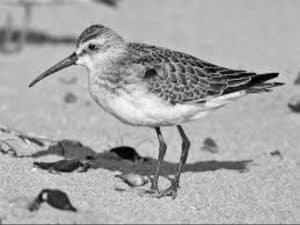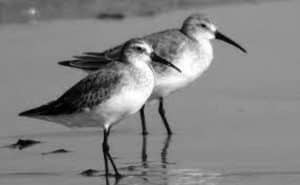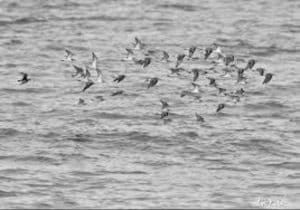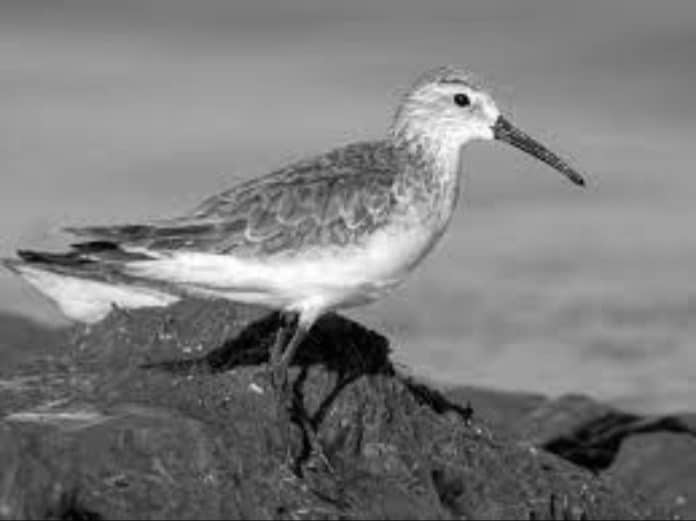Introduction to Curlew Sandpipers
Curlew sandpipers in Tanzania are medium-sized shorebirds that belong to the genus Calidris. They have a distinctive long, down-curved bill that they use to probe the mudflats for invertebrates. During the breeding season, the male curlew sandpipers have a striking black belly and chestnut-colored neck. The females have a duller plumage with brownish-grey feathers and a shorter bill. Juveniles have a similar appearance to the females but lack the reddish tones.
Curlew sandpipers are known for their incredible endurance and navigational abilities. They undertake an annual migration of over 15,000 km from their breeding grounds in the arctic tundra to their wintering grounds in Africa, Australia, and Southeast Asia. This journey takes them across vast deserts, mountains, and oceans, and requires multiple stopovers for rest and refueling.
The Migratory Routes of Curlew Sandpipers
The migration of curlew sandpipers is one of the most impressive natural phenomena. The birds start their journey from their breeding grounds in the arctic tundra in late July and early August. They fly southwards through Siberia and Mongolia, crossing the Himalayas, and reaching the coast of the Yellow Sea in China and Korea. From there, they continue their journey along the coast of Southeast Asia, passing through Thailand, Malaysia, and Indonesia.
Finally, in late September and early October, the curlew sandpipers arrive at their wintering grounds in Africa. Some birds fly directly to the east coast of Africa, while others follow the western route along the Arabian Peninsula and cross the Red Sea to reach East Africa. The migration back to the breeding grounds starts in March and April, and the birds follow the same route in reverse.
Curlew Sandpipers in Tanzania

Tanzania is one of the important stopovers for curlew sandpipers during their migration. The birds arrive in Tanzania in late September and stay until April. They can be seen in various habitats, including mudflats, estuaries, and coastal lagoons. The shallow waters of Lake Natron, Lake Manyara, and Lake Victoria are also important feeding grounds for curlew sandpipers.
During their stay in Tanzania, the curlew sandpipers undergo a remarkable transformation. They molt their breeding plumage and acquire a non-breeding plumage, which is duller and less colorful. They also put on weight and store fat reserves that they will use during their long flight back to the breeding grounds.
The Habitat and Behavior of Curlew Sandpipers in Tanzania
Curlew sandpipers are highly adaptable birds that can thrive in a variety of habitats. In Tanzania, they prefer mudflats and estuaries where they can find their favorite food – invertebrates such as worms, snails, and crustaceans. They use their long, sensitive bills to probe the mudflats and extract their prey.
Curlew sandpipers are social birds that form large flocks during the non-breeding season. They communicate with each other through a variety of calls and displays. During the breeding season, the males perform elaborate courtship displays to attract females. They also defend their territories aggressively against other males.
Conservation Efforts for Curlew Sandpipers in Tanzania
Curlew sandpipers are facing several threats to their survival, including habitat loss, hunting, and climate change. In Tanzania, the main threat to these birds is the degradation of their coastal habitats due to human activities such as pollution, overfishing, and coastal development. The construction of dams and irrigation schemes also affects the availability of suitable wetlands for these birds.
To protect curlew sandpipers in Tanzania, several conservation efforts are underway. The government has designated several wetlands and coastal areas as protected areas, including the Saadani National Park and the Bagamoyo Coastal Zone. NGOs such as BirdLife International and the Wildlife Conservation Society are also working to raise awareness about the importance of these birds and their habitats.
Best Places to Spot Curlew Sandpipers in Tanzania
If you’re interested in spotting curlew sandpipers in Tanzania, the best places to look for them are the coastal areas, estuaries, and mudflats. Some of the top spots include:
- Bagamoyo Coastal Zone
- Saadani National Park
- Lake Natron
- Lake Victoria
- Lake Manyara
It’s important to note that curlew sandpipers are migratory birds, and their presence in these areas is seasonal. The best time to see them in Tanzania is from late September to April.
Tips for Observing Curlew Sandpipers in their Natural Habitat

Observing curlew sandpipers in their natural habitat can be a rewarding experience. Here are some tips to help you make the most of your birdwatching trip:
- Bring a good pair of binoculars or a spotting scope to get a closer look at the birds.
- Wear comfortable clothing and footwear that can withstand wet and muddy conditions.
- Be patient and quiet. Curlew sandpipers are easily disturbed and may fly away if they feel threatened.
- Respect the birds and their habitats. Do not disturb their nests or feeding grounds.
- Join a guided birdwatching tour to learn more about these fascinating birds and their behavior.
Interesting Facts About Curlew Sandpipers
Curlew sandpipers are full of surprises. Here are some interesting facts about these birds:
- Curlew sandpipers have one of the longest migrations of any bird species, traveling over 15,000 km each year.
- During their migration, curlew sandpipers can fly non-stop for up to 60 hours.
- The bill of a curlew sandpiper has more nerve endings than a human hand, allowing them to detect prey in the mud.
- Curlew sandpipers are monogamous during the breeding season, but may mate with multiple partners during the non-breeding season.
- The global population of curlew sandpipers is estimated to be around 500,000 birds.
How to Contribute to Curlew Sandpiper Conservation in Tanzania
If you’re passionate about bird conservation, there are several ways you can contribute to the protection of curlew sandpipers in Tanzania. Here are some ideas:
- Support NGOs such as BirdLife International and the Wildlife Conservation Society that work to protect curlew sandpipers and their habitats.
- Volunteer for local conservation organizations that focus on wetland and coastal conservation in Tanzania.
- Educate yourself and others about the importance of curlew sandpipers and their role in the ecosystem.
- Visit Tanzania and support eco-friendly and sustainable tourism practices that benefit local communities and wildlife.
Conclusion

Curlew sandpipers are a remarkable species of shorebirds that undertake an incredible journey each year. Tanzania is one of the important stopovers for these birds, and it’s a great place to observe them in their natural habitat. By learning more about curlew sandpipers and supporting their conservation, we can help ensure that these high-flyers continue to thrive for generations to come.

































